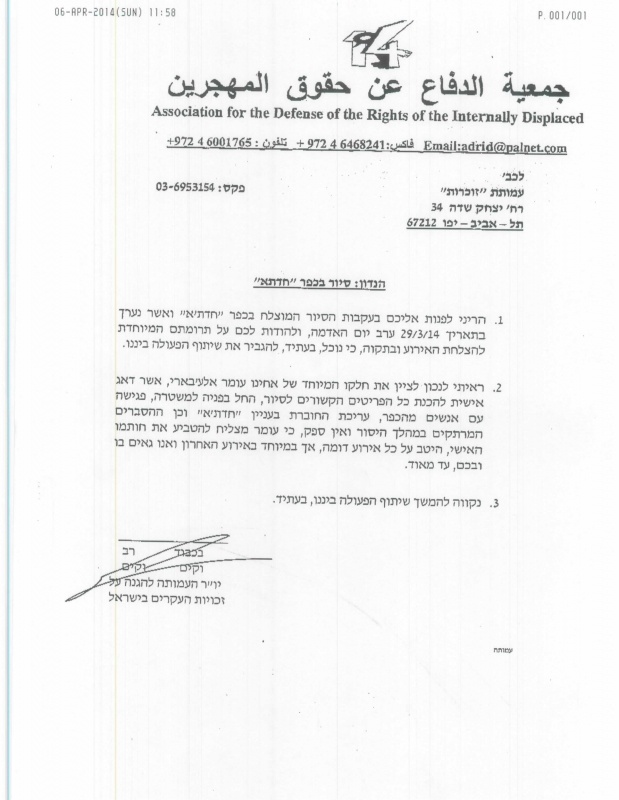By Umar al-Ghubari
A week before the tour in Hadatha I went to the Tiberias Police to inform them of the tour. I did so although there was no fear of any altercation, because the village lands where the tour was to be held are uninhabited, fenced and used for pasture. Our partners in organizing this tour, members of the Committee for the Defense of the Rights of Internally Displaced Palestinians, expected many people to participate, both because of their large membership and because of the proximity to Land Day, the next day, on March 30. We decided it would be best to notify the police just to be on the safe side.
In the police station, they referred me to the tour coordinator. After a short wait, I entered his office and began describing the planned event. The officer was slightly embarrassed, and did not understand why the police should be notified about a tour in an open landscape near a spring frequented by travelers. He had never heard of Zochrot before and didn’t understand what I wanted from him. Then the “clarification” questions began to flow. Who are you? Arabs or Jews? He wondered. Have you held such tours before? Where? What is the purpose? Why Hadatha of all places? Why now of all times? Who will attend? How many? I tried to calm him down and explained to him that usually the police tour coordinators ask me to fill out a special form for such events, and I suggested I do so and go on my way. He wasn’t convinced, and referred me to the “Intelligence Coordinator”. OK, I said. But he’s on duty, he said, and you’ll have to wait. I’ll wait, I said.
It was a long wait. It took about half an hour for Biton, the Intelligence Coordinator to arrive. I thought he was from the security service (shabak). He began questioning me with a sly smile, in an unsophisticated attempt to gather information about others. He asked, will Jews also come? I said yes. He asked, are they leftists? I said, I don’t know. Maybe both kinds. Some dig under abandoned mosques, do you know anything about it? Why am I asking, because if a mosque collapses the Jews will be blamed and all hell will break lose. I said I didn’t know. He concluded by wishing us success – he even blurted, “have fun”, but immediately retracted, “but it’s the Nakba, how can you have fun?” A smile, embarrassment – mine this time – handshake, embarrassment again. We’ll call you, he promised.
Two days before the tour, Biton called as promised. He asked if everything was alright and if the tour would be held on schedule, and then asked several questions about our planned path. At the end of our conversation he claimed that Jews from the area wanted to “make a mess”. “But don’t worry”, he added, “nothing serious, it’ll be OK”.
Saturday morning. Zochrot’s bus left Tel Aviv with about forty participants. Many private cars start arriving in the Hadatha lands. Hadatha is accessible only through a tortuous dirt road that crosses an expansive agricultural landscape. To get there, when driving towards Tiberias, you must turn south from Highway 767 between Kfar Tavor (Mas,ha) and Tiberias, shortly after Sarona, near a brown sign pointing to Ramat Yavne’el (רמת יבנאל), on your right. It is there that the bumpy road to Hadatha begins.
The police, both uniformed and plainclothes officers, is already there. Biton is driving around in an unmarked car, with inquisitive eyes and a huge smile. Nobody pays attention to him. Some 250 people arrived for the tour, mostly Palestinians from the Galilee. The Committee did a fantastic job mobilizing people. We gave everyone a copy of the Zochrot’s Hadatha booklet, issued especially for this event. Most of Hadatha’s refugees have been expelled to Jordan, and live close to the border. A few, of Abu al-Hija family, finally settled northwest of their destroyed village, in Tamra. Many of them were present and served as guides. At the entrance, they posted the traditional Zochrot with the village name that we had prepared in advance.
We then arrived at the village cemetery. Perhaps somebody saw to it that the cows from nearby Jewish settlements will not cross the village lands that day. Usually they roam there and enter the cemetery grounds, desecrating the graves. We posted a sign marking the place as a graveyard. Perhaps this would change people’s attitude and make them feel ashamed for desecrating the memory of the Palestinian dead, still lying here underground.
At the end we gathered near the village’s main spring. Old women and men who had grown up as children in the village shared their memories – homes, agriculture, water, games, holidays, and more. Some of them talked about the village’s occupation in 1948. About fear. About deportation. We walked heavily among the ruined houses. One man said that when the village fell, “the first building the Jews blew up was the mosque”. Then I remembered Biton.



